By Jonathan.Flack - 4 May 2023
I wanted to provide an update for a few fellow members who have inquired about our Starlink journey. I'll do this in multiple parts, focusing on the modifications step by step, each in it's own post, explaining the reasons for each modification as I go.
A bit if background:
I work remotely, and we live on Harlequin, our Hinckley Sou'Wester 42, from May until October. Last season we used a 4g hotspot with service provided by https://www.ispmint.com/ but this service limited us to use in the US, and performance was spotty in some anchorages.
We purchased the Starlink Roam (Dishy McFlatface) in March, and have been steadily modifying the dish, and the power setup for it over the past two months. The goal was to optimize power consumption. Dishy gets power for the phased array antenna over POE, and ensuring the efficiency of the transfer of power from the point of injection, to the dish, is critical.
Starlink ships with its own router, which provides the POE used by the phased array (48+v DC).
If you can get power to the dish via other means, like a POE injector, you do not need the AC powered Starlink wifi router, which also lacks any additional network ports.
Many have asked about the performance. It's good, up to 200Mbit down, and we've seen anywhere from 4-20Mbit upload. Not stunning by modern fiber service performance, but better than 4G by a fair margin.
Roam is permitted in all the areas allowed in your local jurisdiction that are shown on the Starlink service map in blue, with a US$2 per GB surcharge for priority data in the "black" or "ocean" grids.
Here's an image of the global coverage as of May 1:
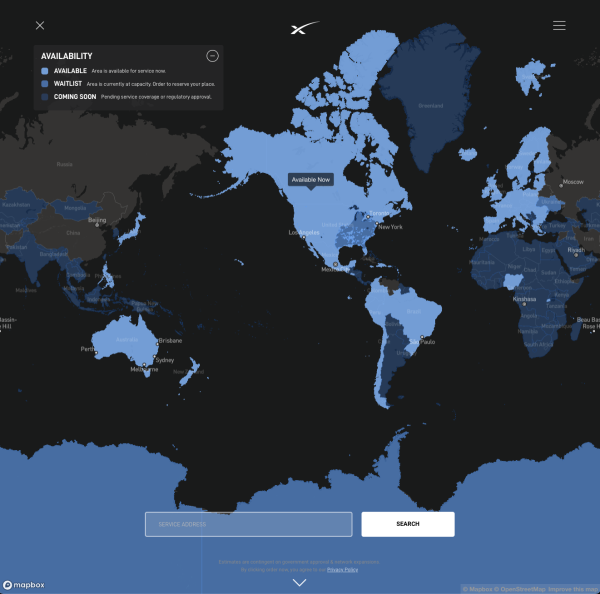
Here in the Pacific Northwest. Notice how the coverage works out once you get away from land too far. The black areas is where the mobile priority data surcharges begin to take effect (this is still a better deal than most satellite plans):
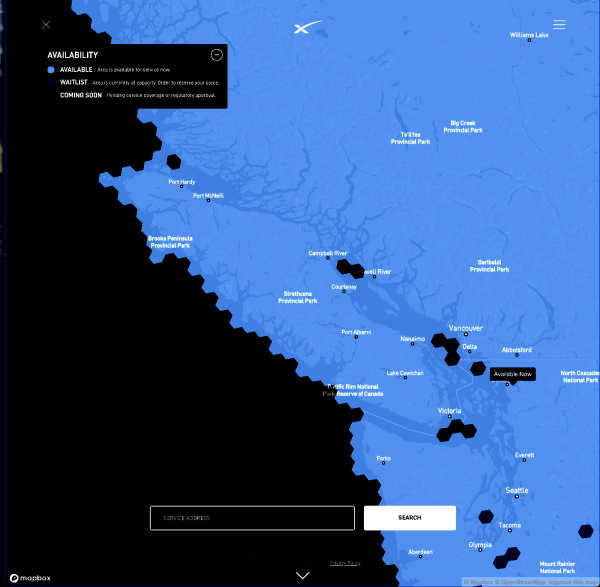
Thankfully, this covers pretty much any place you might want to anchor, and a lot of the area between anchorages. When the time comes to use data for downloading GRIB data or send email, you can simply enable mobile priority and pay the $2/GB surcharge.
Powering Dishy with DC Power
We searched for a long time before settling on https://boondocker.io/ for the POE injection. YouTube is awash in van-lifers who have MacGuyver'd solutions for injecting the requisite power into Dishy, but ABYC, blah, blah.. I wanted something elegant..
Boondocker's board is a work of art. Having made my fair share of boards over the years I can tell you, these guys did their homework. Japanese Nichicon caps are another good indication of how these guys went to extra expense to ensure quality.


I opted for the optional case, and installed the board just behind the power panel in my nav station. I thought briefly about sending 12v DC using some 6 gauge wire to a location closer to the antenna, but felt the risk of getting the power injector wet and causing a failure wasn't worth the potential improvement in power efficiency I'd gain by shortening the POE run.

In my next post, I'll be talking about how we modified the dish, notably about how our approach departs from others who have posted their Dishy mods online.
|
By Jonathan.Flack - 4 May 2023
In the previous post I spoke about our selection of POE injector from https://boondocker.io.
We chose Boondocker for a couple reasons:
• The quality of the board and entire assembly is beautiful. It's a quality piece of kit, full stop.
• You do not have to worry about Starlink's non-standard ethernet wiring scheme. (just cut the wire and use the usual 568-B standard for the wires)
In this post I'll be detailing how we modified Dishy.
Violating Starlink's Warranty
Dishy comes with a 4 leg base, an integrated gimbal and phased array antenna with a 100° field of view.
Most owners I've spoken to on boats who have modified the dish in some manner, experience very solid performance with the dish permanently mounted in a vertical facing orientation. As we are a yawl with a lot of rigging and sheets, we chose removable rail mounts that provide some flexibility to orient the dish by tilting it toward the horizon to account for heeling, or our far northerly cruising grounds. We can mount and unmount the dish in less than a minute.
Step one was to lock Dishy into WTF mode. I did this by putting it face down on the carpet and powering it up. Once the gimbal arm comes to full vertical alignment it was ready to be violated [direct youtube link].
The cut thickness on the table saw is 13/16" if you plan to use StarMount-Systems' Low Profile flat mount kit.
Once the dish has been cut we mounted two Sea-Dog 327199-1 Removable Rail Mount Clamps for Round Tubing to the dish enclosure:

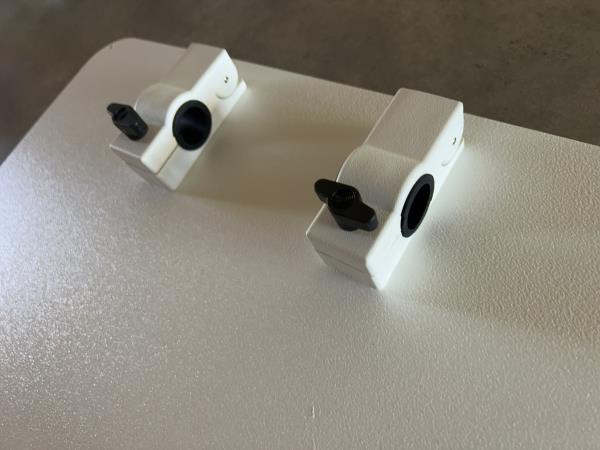

In order to add an extra layer of security (or recoverability) to our dish, we added an Apple Airtag, and Airtag Vault inside the assembly so if someone decided to make off with Dishy while we're ashore, we might have a shot at recovery.
Once complete we have a nice, flat, waterproof Dishy:
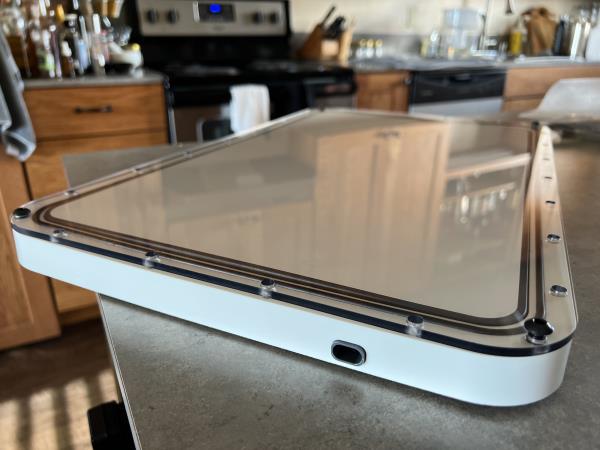
In the next post I'll review the cabling, and choice of router for the boat.
|
By Jonathan.Flack - 5 May 2023
To wire up our violated Dishy we needed to get a few more things, as the Boondocker.io POE injector eliminates the need for the AC router.
The first thing we needed was to wire a jack onto the severed end of Dishy's cable. The original Roam package apparently came with 24awg ethernet wire, which I would have been content with, but the newer systems have been shipping with 26awg ethernet, which is enough for me to consider eliminating as much of the 75 ft cable as possible. 26awg may be enough for 48v POE if you're connected to the grid, but for those of us with limited battery capacity, every watt counts.
From the gland in the coamings to the dish is only about 5 feet, so we shortened the cable to the dish to just 7ft, installing a RJ45 Keystone shielded appropriately for the POE power load.
For the remaining 16.5 ft we are using a beefy 22awg CAT 8 shielded patch cable. The difference between 26awg and 22awg is substantial, and eliminating 51.5 feet of 26awg lossy cable should provide for a measurable power savings.
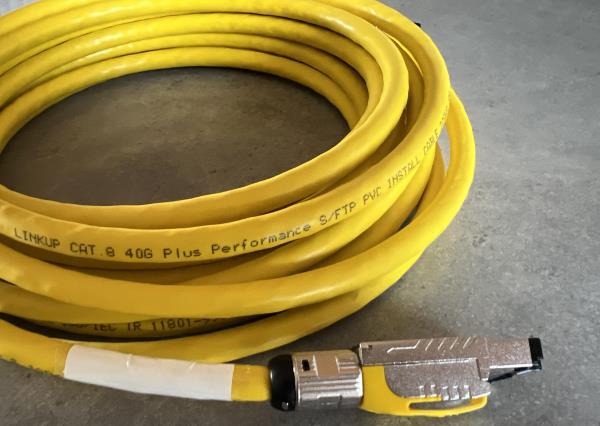
For the router, we found the very capable GL.iNet GL-A1300 (Slate Plus) Wireless VPN Encrypted Travel Router. This router is capable of WiFi speeds that are far greater than Dishy can deliver, it operates on USB-C power. It has a LAN port to connect the Boondocker.io POE injector, and two LAN ports, which allowed us to connect the Hercules 5000 Processor, and use client mode on the Actisense W2K-1 we use to send NMEA2000 data to qtVlm on the Navigation Macbook Pro, leaving one port open for future expansion.
We took this opportunity to update all the 12v (cigarette lighter style) outlets to USB-C, including one behind the main panel. We used the 12V PD Type C Outlet, HOKAAER Quick Charge 4.0 Dual PD Power Outlets. They support 12 or 24v.
We also installed a single 12v 58W Lengthened USB Outlet Socket with Dual 20W PD3.0 USB-C and 18W QC3.0 for those times when someone needs old school USB charging.
Hope this is of some help for someone. We can't say enough good things about Boondocker.io. They are in Nanaimo, BC, Canada, and anyone making quality gear like this deserves our support!
|
By Jonathan.Flack - 5 May 2023
In conclusion, we're pretty happy with Starlink. Support can take days to respond, and anything you do on a boat using the Roam package could just go away at any time, as Starlink updates their Terms of Service almost weekly it seems.
That said, we couldn't do what we do without it. I will be working for at least another 5-7 years, and my employer is exceptional in their gracious willingness to allow us to spend our summers on the ocean, which is the only place on earth where I make sense as a human being. For that, I am grateful to Elon Musk, and SpaceX.
As this summer cruise plays out, and we find ourself further and further north, I will update this thread with our experiences and progress with Starlink.
This recent reply to a support request after receiving a TOS violation notice (we had clipped one of those few inland black grids) provides some clarity on the topic of what SpaceX considers land vs ocean:

The support rep further clarified:
"Ocean: All areas colored as black on the Starlink Availability Map are considered ocean regions. Use in local territorial waters, including inland waters, is contingent on government approval. Only Mobile Priority Data can be used on the ocean. If your Starlink is used within an ocean region, it will require Mobile Priority for use on the Starlink network.
Land: All areas labeled as either "Available", "Waitlist", or "Coming Soon" on the Starlink Availability Map are considered land. Regional Mobile plans can be used on land within your continent, while Global Mobile plans can be used anywhere Starlink has service around the world. If your Starlink is located in a "Land" region, it will be able to connect to the Starlink network on a Regional or Global Mobile Plan."
We're content with this answer, and hope that these definitions don't shift in time.
But while it lasts, we have internet, and a stable network for the boat that delivers some wonderful opportunities for me to work, and still exist in my happy place for most of the year.
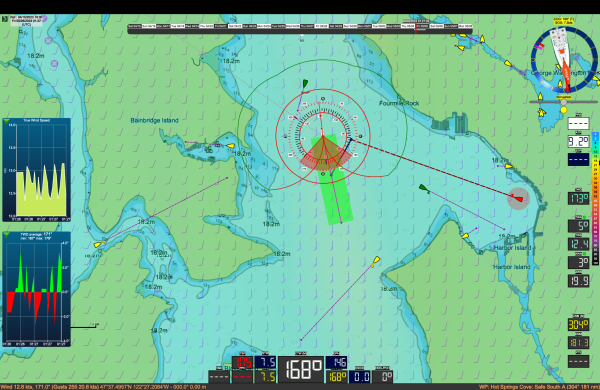
|
By Sonia.Johal - 5 May 2023
Thank you so very much Jonathan 🌞⛵️🙏⛵️🌞
|
By Jonathan.Flack - 5 May 2023
+xThank you so very much Jonathan 🌞⛵️🙏⛵️🌞
It's a pleasure. Let me know if you have any additional questions. Happy to help.
|
By Dick - 5 May 2023
+x+xThank you so very much Jonathan 🌞⛵️🙏⛵️🌞 It's a pleasure. Let me know if you have any additional questions. Happy to help.
Hi Jonathan,
Lovely report: a model of its kind. Pretty sure a lot of the details went over my head (which is fine) and that I will wait till the product/industry has matured, but look forward to the time I can have internet aboard at all (or most) times.
My best, Dick Stevenson, s/v Alchemy
|
By Jonathan.Flack - 5 May 2023
+xHi Jonathan Lovely report: a model of its kind. Pretty sure a lot of the details went over my head (which is fine) and that I will wait till the product/industry has matured, but look forward to the time I can have internet aboard at all (or most) times. My best, Dick Stevenson, s/v Alchemy
Dick,
I believe that that time may be here. The current plan we have restricts us to the mobile network (all the blue areas), and provides better performance than I was getting from Comcast 5 years ago, which is more than adequate, even for streaming, or video conferences (something I do almost all day it seems).
When we go offshore into one of those black cells, it's a simple matter of going to the app and turning on the priority data for $2 per GB. In those cases we're passage-making, so we're typically just going to be sending emails, or downloading gribs with LuckGrib (amazing app btw). You can download a lot of grib files for $2 this way!
So, in short, the service, and service level, are in fact there. What's missing is Starlink providing a hardened product that's engineered for efficiency and survivability on small yachts operating in a hostile marine environment. That is all I've done, water-proofing the phased array antenna (IP65 at least I'd guess), and making it compatible with my 12v systems to optimize efficiency.
My guess is that any competent boatyard can take what I've provided and turn it into a working solution that will be robust and provide years of service for you!
Cheers!
Jonathan
SY Harlequin
|
By Sonia.Johal - 5 May 2023
Thanks Jonathan,
Mine arrived but luckily Im still allowed my roaming option…
I’m having mine professionally installed to be powered off my solar… I hope you don’t mind me sharing your report for ideas? I certainly will be making use of your very kind offer should there be any questions.
Wishing you a fab bank holiday weekend,
Fair Winds,
Sonia
SY Salacia
|
By Jonathan.Flack - 5 May 2023
+xThanks Jonathan,Mine arrived but luckily Im still allowed my roaming option…I’m having mine professionally installed to be powered off my solar… I hope you don’t mind me sharing your report for ideas? I certainly will be making use of your very kind offer should there be any questions.Wishing you a fab bank holiday weekend,Fair Winds,SoniaSY Salacia
Absolutely, feel free to use anything you need from here.
If you're powering from solar you likely want to wire the POE injector right off your main electrical panel, and eliminate as much of the wire run as possible. Run nice, fat gauge wires to the POE injector. The dish draws 100w@48v for the entire power-up cycle, so it's a power hungry appliance. The little wifi router I used has been great, and runs on almost zero power.
We have Lithium batteries, so we have adequate reserves to run Dishy for days, but I still turn it off when not using given it's appetite for energy.
I STRONGLY advise getting the boondocker.io injector. I tried two others and they were too sketchy for a marine application, one got very hot. Boondocker's runs nice and cool, and is made from quality electronic components. I can't say enough good things about them. It's the best $150 I spent on the whole project.
|
By simoncurrin - 11 May 2023
Great thread Jonathan. We too have been very impressed with Starlink RV during our 6 month cruise from the Chesapeake to Panama. It even worked in Cuba and allowed us to take part in a video conference whilst mid passage passage between Cayman and Columbia.
I've just been offered (by Starlink) a $600 discount on an upgrade to the in-motion flat panel which I'm considering for our forthcoming Pacific crossing. Quite a big investment and more difficult to accommodate on a sailboat but it is fully accredited for use offshore and when underway.
Simon
|
By Sonia.Johal - 12 May 2023
Thanks Simon,
Pls would you update us on your new flat panel ? 🙏
|
By Jonathan.Flack - 12 May 2023
I have heard from others that the power draw on the larger panel is over double that of the smaller RV panel. That ruled it out for us.
|
By Dick - 20 May 2023
+x+xThanks Jonathan,Mine arrived but luckily Im still allowed my roaming option…I’m having mine professionally installed to be powered off my solar… I hope you don’t mind me sharing your report for ideas? I certainly will be making use of your very kind offer should there be any questions.Wishing you a fab bank holiday weekend,Fair Winds,SoniaSY Salacia Absolutely, feel free to use anything you need from here. If you're powering from solar you likely want to wire the POE injector right off your main electrical panel, and eliminate as much of the wire run as possible. Run nice, fat gauge wires to the POE injector. The dish draws 100w@48v for the entire power-up cycle, so it's a power hungry appliance. The little wifi router I used has been great, and runs on almost zero power. We have Lithium batteries, so we have adequate reserves to run Dishy for days, but I still turn it off when not using given it's appetite for energy. I STRONGLY advise getting the boondocker.io injector. I tried two others and they were too sketchy for a marine application, one got very hot. Boondocker's runs nice and cool, and is made from quality electronic components. I can't say enough good things about them. It's the best $150 I spent on the whole project.
Hi all,
I read the following series of comments on another stream and, although quite ignorant of the topic, thought that this might be of interest here. With permission, I have copied and pasted their comments.
My best, Dick Stevenson, s/v Alchemy
Here is some more information on Starlink at sea:
https://www.yachtingworld.com/all-latest-posts/starlink-at-sea-all-change-for-cruisers-145597?utm_term=067605B7-6200-4E19-A30C-3CC65FBCEB31&utm_campaign=F0BD7058-F52D-447F-B2FD-A269004F0791&utm_medium=email&utm_content=3FD76EDE-B714-4897-993B-AAB182F53A1E&utm_source=SmartBrief
To add to his answer of your second question.
You wrote "it would be great, as I think you say, that we could switch back & forth between our current “Standard+Portability service” & the “Maritime/Mobility service” depending on monthly needs?."
Starlink no longer offers the “Residential+Portability Option". When Starlink announced the 2nd round of price hikes they also announced that they were removing the Portability Option. The Portability Option was the extra $25.00/month you could pay to make your dish 'portable,' or able to be used in multiple locations like the RV service. They allowed existing customers with the "Residential" plan with the "Portability Option" to keep it. In other words, they "grandfathered" that plan, but only for existing users already on that plan. However, once you switch plans, you can never return to the "Residential" plan with the "Portability Option".
If you have the "Residential" plan (now called "Standard" plan) with the "Portability Option", and you want to keep it, do not change plans.
Thanks for sharing this, it’s an excellent post. One thing I would add to anybody considering disabling the motors is that it isn’t really needed anymore. Once the boat starts moving the dish will orient itself horizontally anyway.
It may be worth doing if you don’t want to wait for it to figure itself out, or if you are swinging 180 degrees at anchor but even then we’ve found that as more and more satellites are in orbit it doesn’t seem to matter where the dish points were getting reasonably good connectivity most of the time.
To answer points one and two, I have a gen 1 Starlink dish, I’m using the regional plan with roaming, and I opted in to priority data which is needed for ocean use for this passage although it isn’t being enforced yet.
It isn’t at least as far as I can tell an option to use the maritime/mobility plan without the high performance dish, but the priority data option is pretty cost effective for short periods offshore.
We’ll be switching back and forth between global/regional/mobile etc once we get to our next cruising grounds.
Right now I’m about 800 miles offshore on the way to the gambier islands and it hasn’t missed a beat. That said we still have our iridium go as a backup as when we left the new plans were still a bit ambiguous and it wasn’t entirely clear what combos would be supported so I wanted a backup.
We’ll probably still keep the go for ocean passages or switch to a garmin Inreach/bivistick or similar device in case things go south.
Starlink won’t warranty the non high performance dishes for in motion/ocean use so if it breaks you’ll need to buy a new one but they are allowing you to use it within their terms of service now - something that wasn’t permitted (although it worked just fine) until recently.
We’ve had Starlink on board for about a year, I work remotely from the boat and it has opened up cruising areas that just weren’t an option for me before, the dish has been hanging off the back of the boat in all weather including hurricane Kay last fall and seems to be doing just fine, of course there’s no real way to predict at what point it will succumb to the marine environment but it does seem to be pretty robust.
Time will tell how aggressively they restrict use at sea, the consensus is generally that nearshore will continue to be classed as onshore in which case paying a couple of dollars per gigabyte on a passage is a good deal. If they are more aggressive it might generally work out cheaper to switch a dedicated maritime plan depending on how much data you consume.
|
By Jonathan.Flack - 2 Jun 2023
+x[quote]Starlink won’t warranty the non high performance dishes for in motion/ocean use so if it breaks you’ll need to buy a new one but they are allowing you to use it within their terms of service now - something that wasn’t permitted (although it worked just fine) until recently.
We’ve had Starlink on board for about a year, I work remotely from the boat and it has opened up cruising areas that just weren’t an option for me before, the dish has been hanging off the back of the boat in all weather including hurricane Kay last fall and seems to be doing just fine, of course there’s no real way to predict at what point it will succumb to the marine environment but it does seem to be pretty robust.
The high performance dish consumes twice the power of the "Dishy" RV unit, and given what we've seen (4-6A under normal conditions) that would make the power draw close to 100Ah per work day, which is a bit outside the power budget for most cruising sailors who have other systems like Refrigeration, etc. to run. It's also extremely expensive, so you can likely get 4 RV dishes and modify them before you hit the cost of the high performance dish (double the size as well). I don't see any upside to not just carrying a spare if it comes to that.
Starlink has been very up front about the plans. If you are in a blue cell on the maps I provided your roaming plan covers you on the content you have listed as home continent, however if you touch a black cell, you need the priority roaming which comes at a $2/gb premium. We opt into that when absolutely necessary (it can be done on demand), but power the dish off when not downloading weather/coms offshore.
For most of us, 2gb is a lot of grib files, so I can't imagine spending more than $20-30 for data on a crossing. We'll keep everyone posted as we make our way north this summer.
|
By simoncurrin - 16 Nov 2023
Another great overview article on Starlink.
https://fetchinketch.net/2023/11/15/starlink-information-for-cruisers-what-plan-to-use/
Simon
|
By Joerg.Esdorn - 27 Apr 2024
+xAwesome thread!!! Thank you so very much. We just did the passage from Panama>Honduras>Belize>Mexico>Cuba>Florida on Iridium and it sucks. We've had Iridium for over 10 years and want to make a change. Question - should we purchase Starlink equipment and plan in the USA or in Northern Europe? ~Charles
Charles, it depends where you are using the dish. If you are in Florida, you should get it in the US because then your roaming plan is for the North American continent, which includes the Caribbean and also some of Middle America. If you then sail to Europe, you can sell the equipment to yourself using a different email address and an address in Europe. Your roaming plan will then work in all of Europe. The aim is to avoid having to use the Global Roaming plan which costs at least $100 more per month.
|
By simoncurrin - 27 Apr 2024
Charles,
Joerg is right. Shop around for the cheapest subscription in the region you want to visit and make that your service address. We just registered ours in Australia as we are now in Oceania.
Simon
-id="7902" class="if-quote-wrapper" unselectable="on">+xAwesome thread!!! Thank you so very much. We just did the passage from Panama>Honduras>Belize>Mexico>Cuba>Florida on Iridium and it sucks. We've had Iridium for over 10 years and want to make a change. Question - should we purchase Starlink equipment and plan in the USA or in Northern Europe? ~Charles
|
|